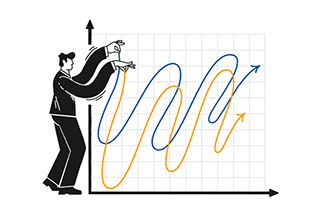What Canadian Investors Want to Know: Top 5 Insights from Our Survey
Written by The Inspired Investor Team | Published on February 3, 2021
Written by The Inspired Investor Team | Published on February 3, 2021
In 2020, Canadians started self-directed investing in record numbers, looking for opportunities — and to take charge of their financial futures. We asked Canadian online investors* about their investing journeys and, in particular, what they want to know more about.
The number one topic of interest? Investing strategies, chosen by 41 per cent of poll participants. Stock trading came in a close second at 40 per cent, followed by exchange-traded funds (ETFs) at 35 per cent, options at 30 per cent and diversification at 24 per cent. Short selling wasn't far behind, with 23 per cent of respondents wanting to know more about that specific strategy, so even though it didn't break the top five, we are offering the scoop. Here we break down all six areas of interest.
1) Investing Strategies
Investing strategies guide your portfolio choices. Think of your strategy as your game plan (which is what investors like Brandon¹ do). It will largely be based on your goals, how long you plan to invest and how much risk you're comfortable with — all of which will help determine what investments are the right fit for you. Some investors may choose to focus on safety and comfort, accepting a lower rate of return from investments in exchange for more predictable earnings. Others may be looking for regular income through dividends or a combination of income and capital growth, and still others will focus on maximizing growth opportunities.
There are a number of specific strategies you'll often hear about. Here are some of the common ones:
In addition to these strategies, investors are increasingly choosing to build their portfolios around the principles of responsible investing, combining financial considerations and environmental, social and governance issues that are important to them.
FAST FACT: You might also hear about dollar-cost averaging as an investing strategy. This involves investing a set dollar amount on a regular basis regardless of current market prices, rather than investing a lump sum all at once. |
There's no one-size-fits-all when it comes to investing strategies — finding what works for you is what's most important.
2) Stock Trading
Stock trading is often one of the reasons why investors decide to take control of their investments. Stocks — or equities, as they're often called — can be a valuable part of your investment portfolio. Owning stocks in different companies can help you build your savings, protect your money from inflation or maximize income from your investments. But it's important to know that there are always risks when investing in the stock market. Once you understand the risk-return relationship, it's good to explore the different features of common and preferred shares, as well as key trading basics such as bid and ask and order types. Find out more in our Guide to Investing in Stocks.
FAST FACT: When you buy a stock, you own a share (think: small slice) of a company. |
3) Exchange-Traded Funds (ETFs)
ETFs have been gaining in popularity over the past number of years, so it's no surprise investors want to understand them better. Similar to a mutual fund, an ETF is a pooled investment vehicle that owns a basket of underlying securities and divides ownership of those securities into shares. Shares or units of ETFs can be bought and sold on a stock exchange throughout the trading day, like stocks. An ETF's underlying securities are largely determined by its investment objective. Common underlying assets are stocks, bonds, commodities and currencies.
Like all investments, ETFs present a number of benefits and risks for investors. Buying and selling ETFs is similar to trading stocks. You'll want to look at things like volume, liquidity and the bid/ask spread, all of which you can find in a Detailed Quote. To find out more, explore the full Guide to Investing in ETFs.
FAST FACT: You may have heard of ETFs in the context of mutual funds — or vice versa. The two types of investment funds have some similarities but also key differences. Learn more in How Do ETFs Compare to Mutual Funds? |
4) Options Trading
Many investors (like Orion¹) consider diving into options trading a natural progression after dipping their toes into stock trading. While some options trading strategies can be very complex, options themselves are relatively straightforward. An option is a contract between a buyer and a seller that speculates on the future price of an asset, like a stock, for example. Since it's a contract, buyers and sellers have certain rights and obligations to the other party.
There are two main types of options: calls and puts. Calls give buyers the right to buy a security at a predetermined price; puts give buyers the right to sell a security at a predetermined price. Unlike stocks, options come with an expiration date and an exercise price (learn the lingo in our options glossary); they don't come with shareholder rights or pay dividends; and they generally cost only a fraction of the price of the underlying asset.
To explore the options available for a security you may be interested in, click the options tab on its Detailed Quote. Remember, options can be high-risk instruments, so it's important to closely monitor your investments and understand how much risk you're taking on at any given time. Find out more about options in the Options Trading Guide.
"An option is a contract between a buyer and a seller that speculates on the future price of an asset, like a stock."
5) Diversification
As its name denotes, diversification refers to the degree of variety in an investment portfolio — generally, the more variety, the more diversified it is. Your mix of investments, also known as asset mix, is considered by many to be key to successful long-term investing. Since financial markets typically don't move in the same direction at the same time, investing in different types of investments, or “asset classes," may help you ride out market fluctuations. The idea is that if some of your investments are performing poorly, stronger performers elsewhere in your portfolio may help balance things out.
Diversification can mean different things to different investors. While some consider a balance of major asset classes such as fixed income, equities and cash right for them, others view holding stocks in various industry sectors as sufficient diversification. You can learn more about diversification in Pleasing a Dinner Crowd Can Be Surprisingly Similar to Diversifying a Portfolio.
FAST FACT: Studies, including the landmark paper “Determinants of Portfolio Performance," published in 1986, suggest that your asset mix is the most important decision you can make in investing — even more than choosing specific investments like stocks or mutual funds. |
BONUS: Short selling
Thanks to Hollywood blockbusters, even brand new investors may have heard of short selling. In a nutshell, short selling is an investing strategy that aims to profit from a tumbling stock price. Investors borrow shares from a brokerage and sell them immediately, in the hopes of buying them back later at a lower price. If the short is successful, the shares are purchased at that lower price, and returned to the brokerage, and the investor keeps the difference in price (minus costs, of course).
Short selling, also known as taking a short position in a company's stock, is a more complex process than traditional stock trading. In order to short sell, investors are required to have a non-registered margin account, rather than the more typical investment cash account.
It's important to know that short selling's potential losses are limitless, and its potential gains are limited. When you short a stock, you lose as the stock price rises. Because a stock's price can, in theory, rise indefinitely, you could lose much more than your initial investment. Conversely, when you short a stock, you gain as the price falls. Because a stock's price can only fall to zero, your gains are limited to the difference between the original price of your short and zero. Find out more in What is Short Selling and How Does it Work?
"It's important to know that the potential for loss in short selling is limitless, while potential gains are limited."
To explore other investing topics, visit the Investing Academy at RBC Direct Investing.
*The results come from a poll, conducted by DIG Insights for RBC Direct Investing, of 1,836 of Canada's online investors (including 848 RBC Direct Investing clients) between October and November 2020.
RBC Direct Investing Inc. and Royal Bank of Canada are separate corporate entities which are affiliated. RBC Direct Investing Inc. is a wholly owned subsidiary of Royal Bank of Canada and is a Member of the Investment Industry Regulatory Organization of Canada and the Canadian Investor Protection Fund. Royal Bank of Canada and certain of its issuers are related to RBC Direct Investing Inc. RBC Direct Investing Inc. does not provide investment advice or recommendations regarding the purchase or sale of any securities. Investors are responsible for their own investment decisions. RBC Direct Investing is a business name used by RBC Direct Investing Inc. ® / ™ Trademark(s) of Royal Bank of Canada. RBC and Royal Bank are registered trademarks of Royal Bank of Canada. Used under licence.
© Royal Bank of Canada 2021.
1 These current or former RBC employees have shared their personal stories. Some of their identifying details have been changed for privacy reasons.
The views and opinions expressed in this publication are for your general interest and do not necessarily reflect the views and opinions of RBC Direct Investing. Furthermore, the products, services and securities referred to in this publication are only available in Canada and other jurisdictions where they may be legally offered for sale. If you are not currently resident of Canada, you should not access the information available on the RBC Direct Investing website.

When markets swing, how you place a trade can make a difference

Here’s what we saw on the trading floor in April 2025

Here’s what we saw on the trading floor in March 2025